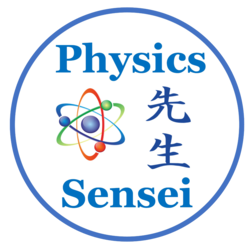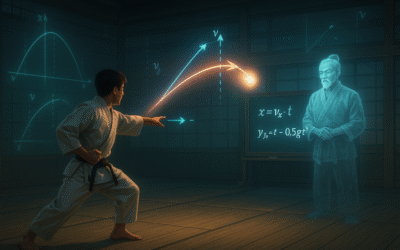🥋 Newton’s Second Law – White to Black Belt Mastery
“Force equals mass times acceleration.”
White Belt Level – Key Concept
Newton’s Second Law connects force, mass, and acceleration.
It explains how motion changes when a net force acts on an object.
In simple words: More force → More acceleration (for the same mass).
🎮 Explore: PhET Simulation – Forces and Motion: Basics
Core Principles
- Acceleration (a⃗) happens only when there is a net force (ΣF⃗ ≠ 0).
- Mass (m) measures how much an object resists acceleration.
- Formula: ΣF⃗ = m a⃗
- SI units:
- Force (F) in newtons (N)
- Mass (m) in kilograms (kg)
- Acceleration (a⃗) in meters per second squared (m/s²)
📖 Learn more: OpenStax University Physics, Ch. 4
Key Equations (SI Units)
- ΣF⃗ = m a⃗
- 1 N = 1 kg·m/s²
📄 Reference: OpenStax – Physics Formula Appendix
Common Mistakes and Pitfalls
- Forgetting to use net force (sum of all forces, not just one).
- Mixing up mass and weight (weight is a force, W = m g).
- Forgetting to convert mass into kilograms.
🔎 See also: HyperPhysics – Newton’s Second Law
Sensei’s Shortcuts
💡 Double-Check Trick: If acceleration looks too big or too small, check your units. Most mistakes come from missing conversions.
Worked Example – Step by Step (White Belt)
Problem: A 10.0 kg box is pushed with a net force of 25.0 N. What is its acceleration?
Step 1. Formula:
ΣF = m a
Step 2. Substitution:
25.0 N = 10.0 kg × a
Step 3. Solve for a:
a = 25.0 / 10.0 = 2.50 m/s²
Step 4. Final Answer:
a = 2.50 m/s²
Practice Drill (White Belt)
- A 2.00 kg ball is acted on by a net force of 6.00 N. What is its acceleration?
Answer: 3.00 m/s² - A 20.0 kg cart accelerates at 1.50 m/s². What is the net force?
Answer: 30.0 N
Yellow Belt Extension – Deeper Skills
Problem: A 1,200 kg car accelerates from rest under a net forward force of 3,600 N. What is its acceleration?
Solution Outline:
- Formula: ΣF = m a
- Substitution: 3,600 = 1,200 × a
- a = 3.00 m/s²
Final Answer: a = 3.00 m/s²
🎮 Test this yourself: Adjust mass and force in PhET Forces and Motion: Basics.
📖 Extra reading: Khan Academy – Newton’s Second Law
Black Belt Mastery – Exam Strategy and Challenge
Challenge Problem: A 75.0 kg astronaut pushes a 250 kg satellite in space with a force of 100 N for 5.00 s.
a) What is the satellite’s acceleration?
b) What velocity does it gain after 5.00 s?
c) What happens to the astronaut (assume no other forces)?
Strategy Notes:
- Use ΣF = m a for both astronaut and satellite.
- Remember Newton’s Third Law (equal and opposite force).
- Then use v = a t for velocity change.
Solution:
a) a = F / m = 100 / 250 = 0.400 m/s²
b) v = a × t = 0.400 × 5.00 = 2.00 m/s
c) Astronaut mass = 75.0 kg
Acceleration = F / m = 100 / 75.0 = 1.33 m/s² (opposite direction)
Velocity after 5.00 s = 1.33 × 5.00 = 6.67 m/s (backward)
Final Answers:
a) a = 0.400 m/s²
b) v = 2.00 m/s (forward)
c) Astronaut velocity = 6.67 m/s (backward)
🚀 Related: NASA – Newton’s Laws in Space
Sensei’s Final Words
Newton’s Second Law is the engine of motion. Every problem comes down to forces, mass, and acceleration. Ask yourself: What are the forces? What’s the mass? Then find the acceleration. Master this law, and motion becomes clear.


0 Comments